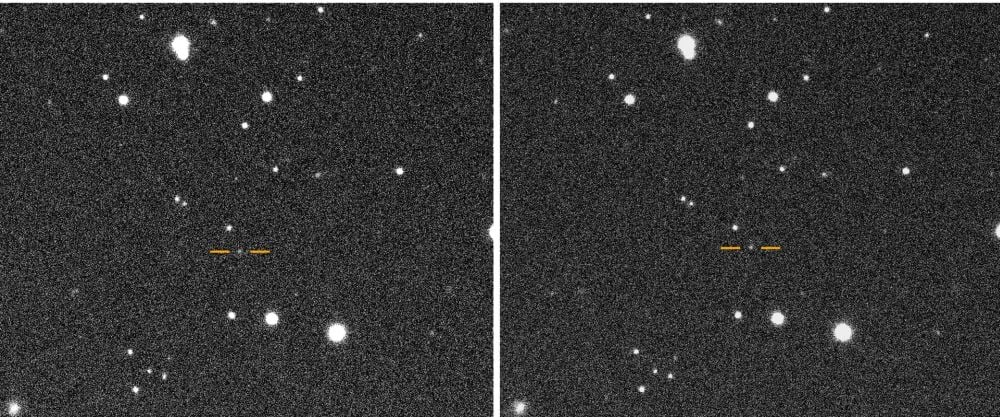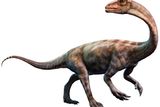Science
New Asteroid Discovered Near Earth, Hidden in Sun’s Glare

A newly discovered asteroid, designated as 2025 SC79, poses a potential risk to Earth due to its proximity and difficult visibility. Identified by astronomer Scott S. Sheppard from the Carnegie Institute for Science, this asteroid is part of the rare Atira asteroid group, which consists of near-Earth objects that orbit entirely within Earth’s orbit. The discovery was made on September 27, 2023, using the Dark Energy Camera on the National Science Foundation’s Blanco 4-meter telescope.
The Atira group is particularly challenging to monitor because these asteroids are often hidden in the Sun’s glare, making their detection difficult. 2025 SC79 is the 39th member of this group and is notable for being only the second known asteroid to have an orbit completely confined within the orbit of Venus. It crosses the orbit of Mercury and has a remarkably short orbital period of just 128 days, making it one of the fastest orbiting asteroids in the Solar System.
At approximately 700 metres (2,300 feet) in diameter, 2025 SC79 is significantly smaller than the asteroid that led to the extinction of the dinosaurs, known as the Chicxulub impactor. Nevertheless, its size is substantial enough to cause catastrophic damage on a continental scale if it were to collide with Earth. Depending on its impact location, the consequences could be devastating for both human and animal populations.
Sheppard emphasized the detection challenges associated with asteroids that are positioned near the Sun. “The most dangerous asteroids are the most difficult to detect,” he stated in a press release. “Asteroids lurking near the Sun can only be observed during twilight—when the Sun is about to rise or set.” This limited visibility makes it crucial to track these objects, as they may pose serious impact risks if they approach Earth.
Future Observations and Research
Further studies of 2025 SC79 will be necessary to gain insights into its composition and origins, but astronomers must wait for its return visibility in several months. The asteroid’s survival against the Sun’s intense heat raises questions about its material makeup. It is possible that it originated from the main asteroid belt before being influenced by gravitational perturbations that altered its orbit.
Understanding such dynamics is essential for planetary defense and for uncovering the history of our Solar System. As Sheppard noted, “Many of the Solar System’s asteroids inhabit one of two belts of space rocks, but perturbations can send objects careening into closer orbits where they can be more challenging to spot. Understanding how they arrived at these locations can help us protect our planet and also help us learn more about Solar System history.”
As astronomers continue to explore and monitor these hidden asteroids, the knowledge gained will be invaluable in assessing potential threats and enhancing our understanding of the celestial bodies that share our cosmic neighborhood.
-

 Business4 days ago
Business4 days agoUK to Finalize Stablecoin Regulations by 2026, Boosting Crypto Sector
-

 Business5 days ago
Business5 days agoU.S. and U.K. Target Cybercriminal Networks, Seize $15 Billion
-

 World4 days ago
World4 days agoMilitary Artillery Plan Sparks Safety Concerns Along California Highway
-

 Lifestyle5 days ago
Lifestyle5 days agoKISS OF LIFE’s Natty Dazzles in Micro-Shorts at Seoul Event
-

 World5 days ago
World5 days agoTrump Signals Reluctance to Sell Tomahawk Missiles to Ukraine
-

 Business5 days ago
Business5 days agoCalifornia to Eliminate All Plastic Bags from Stores by 2026
-

 Entertainment5 days ago
Entertainment5 days agoLouisiana Senate Raises Concerns Over Medicaid Cuts Amid New Bill
-

 Sports5 days ago
Sports5 days agoDomenico Doran’s Stellar Performance Leads Bishop Amat to Victory
-

 Entertainment5 days ago
Entertainment5 days agoUtah Communities Rally as Government Shutdown Strains Resources
-

 Sports5 days ago
Sports5 days agoTrade Low, Trade High: Key NHL Players to Consider Now
-

 Science2 days ago
Science2 days agoAncient Dinosaur Discovery in Argentina Reveals Evolutionary Insights
-

 Health2 days ago
Health2 days agoUncovering the Hidden Link Between Knee Pain and Hip Issues









